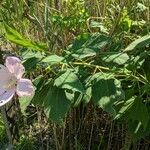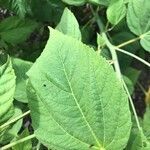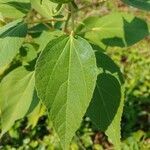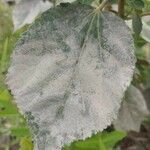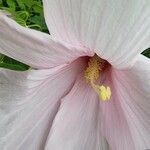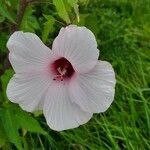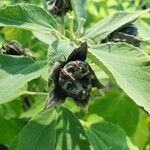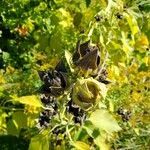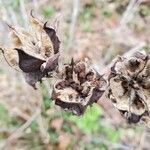Herbs perennial, erect, 1-2.5 m tall; stem stellate pubescent or nearly glabrous. Stipules silklike, caducous; petiole 4-10 cm, puberulent; leaf blade ovate to ovate-lanceolate, sometimes with 2 lateral lobes, 10-18 × 4-8 cm, abaxially gray-white tomentose, adaxially nearly glabrous or minutely puberulent, base cuneate or nearly rounded, margin bluntly dentate, apex caudate. Flowers solitary, axillary. Pedicel 4-8 cm, very sparsely stellate puberulent, articulate near apex. Epicalyx lobes 10-12, filiform, ca. 18 × 1.5 mm, densely stellate puberulent. Calyx 1/2 as long as epicalyx, lobes rounded, connate for more than 1/2 of length. Corolla white, pink, red, or purple, with dark red center, 10-14 cm in diam.; petals obovate, ca. 10 cm, abaxially sparsely pilose, adaxially bearded on margin. Staminal column ca. 4 cm. Ovary glabrous; style branches 5, sparsely scabrous. Capsule conic-ovoid, 2.5-3 cm; mericarps 5. Seeds reniform, 2-3 mm in diam., apex pointed. Fl. Jul-Sep.
Perennial 1–2 m, the stems canescent above; lvs lanceolate to ovate, occasionally shallowly lobed beyond the middle, glabrous or soon glabrate above, stellate-canescent beneath; peduncles jointed near or above the middle, often bearing a ± well developed lf; involucral bracts usually not ciliate, cor 10–20 cm wide, pink or white, often with a red or purple center; fr rounded or tapering to the often short-beaked summit, glabrous except the sutures; seeds glabrous; 2n=38. Marshes along the coast and inland; Mass. and N.Y. to O., s. Wis., and Mo., s. to the Gulf, and disjunct in Calif.; sometimes escaped elsewhere. Most of our plants are var. moscheutos, as described above. (H. palustris) The mostly more southern or western var. occidentalis Torr., with the frs and both sides of the lvs pubescent, and the bracts usually ciliate, enters our range in s. Ill., w. Ky., and adj. Ind. (H. lasiocarpus)
A bushy herb. It is erect and coarse. It keeps growing from year to year. It is similar to okra. It grows 1-2.5 m tall. The leaf stalk is 4-10 cm long. The leaves are broad and angular. Sometimes they have 2 side lobes. The leaf blade is 10-18 cm long by 4-8 cm wide. The flowers occur singly in the axils of leaves. The flower has 5 petals. They are cream coloured. It has a yellow centre. Flowers are 10-14 cm across. The fruit is a capsule which is cone shaped. It is 2.5-3 cm across. The seeds are kidney shaped and 2-3 mm across.
